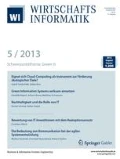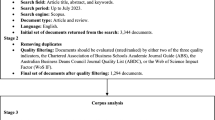Abstract
Procurement has become increasingly important for organizations acting in dynamic supply chains and competitive markets. In practice however, companies struggle with adapting and improving their procurement business function. In line with the general trend in management and organization studies, both scholars and practitioners aim to define an integrated procurement policy that is truly aligned on all organizational and IT aspects. The central aim of this paper is to present a framework that supports the definition and application of such an integrative procurement approach. The framework is developed upon insights from IT business alignment (more specifically IT Procurement alignment), procurement maturity measurement and segmentation. It facilitates organizations in monitoring the maturity and alignment of their procurement on five different business/IT perspectives. In addition, the framework enables specific procurement improvements by taking the situational aspect of procurement segmentation into account. The framework was validated twice: through interview expert consulting and through a questionnaire using scale analysis. In a case study it was found suitable for assessing procurement maturity and identifying concrete procurement improvements.
Similar content being viewed by others
References
Adamson, J.: Why is eProcurement failing? Supply Management. http://www.tranmit.com/newsroom/0401_sm.htm, 2001–04. Retrieved 2006-06-27.
Avison, D.; Jones, J.; Powell, P.; Wilson, D.: Using and validating the strategic alignment model. In: Journal of Strategic Information Systems 13 (2004) 3, pp. 223–246.
Al-Mashari, M.; Al-Mudimigh, A.; Zairi, M.: Enterprise resource planning: A taxonomy of critical factors. In: European Journal of Operational Research 146 (2003) 2, pp. 352–364.
Avery, S.: How Invensys plans to reap supply value. In: Purchasing. http://www.purchasing.com/article/CA138189.html, 2000-04-20. Retrieved 2006-06-27.
Batenburg, R.; Versendaal, J.: Business alignment in the CRM Domain: Predicting CRM performance. In: T. Leino, T. Saarinen & S. Klein (Eds.): Twelfth European Conference on Information Systems, ECIS 2004. Turku Finland (2004), CD-Rom.
Batenburg, R.; Versendaal, J.: Alignment matters — Improving business functions using the Procurement Alignment Framework. Technical Report Utrecht University UU-CS-2006-002 (2006).
Berkowitz, M.; Mohan, K.: The role of global procurement in the value chain of Japanese steel. In: Colombia Journal of World Business 22 (1987), pp. 97–110.
Brynjolfsson, E.; Hitt, L. M.: Paradox lost? Firm-Level Evidence on the Returns to Information Systems Spending. In: Management Science 42 (1995) 2, pp. 541–558.
Brynjolfsson, E.; Hitt, L. M.: Beyond Computation: Information Technology, Organizational Transformation and Business Performance. In: The Journal of Economic Perspectives 14 (2000) 4, pp. 23–48.
Braun, C.; Winter, R.: Classification of Outsourcing Phenomena In Financial Services. In: Bartmann, D.; Rajola, F.; Kallinikos, J.; Avos, D.; Winter, R.; Eindor, P.; Becker, J.; Bodendorf, F.; Weinhardt, C. (Eds.): Thirteenth European Conference on Information Systems, ECIS 2005. Regensburg Germany (2005), CD-Rom.
Brynjolfsson, E.: The Productivity Paradox of Information Technology. In: Communications of the ACM 35 (1993) 12, pp. 66–77.
Carr, L. P.; Ittner, C. D.: Measuring the cost of ownership. In: Journal of Cost Management 6 (1992) 3, pp. 7–13.
Cavinato, J. L.: Evolving procurement organizations: logistics implications. In: Journal of Business Logistics 13 (1991), pp. 27–45.
Cavinato, J. L.: Fitting purchasing to the five stages of strategic management. In: European Journal of Purchasing and Supply Management 5 (1999) 2, pp. 75–83.
Chen, Injazz J.; Paulraj, Antony; Lado, Augustine A.: Strategic purchasing, supply management, and firm performance. In: Journal of Operations Management 22 (2004) 5, pp. 505–523.
Cragg, P.; King, M.; Hussin, H.: IT alignment and firm performance in small manufacturing firms. In: Journal of Strategic Information Systems 11 (2002) 2, pp. 109–132.
Davila, A.; Gupta, M.; Palmer, R.: Moving Procurement Systems to the Internet: — the Adoption and Use of E-Procurement Technology Models. In: European Management Journal 21 (2003) 1, pp. 11–23.
Earl, M. J.: Management Strategies for Information Technologies. Prentice Hall, New Jersey 1989.
Ellram, L. M.; Siferd, S.P.: Total Cost of Ownership: A Key Concept in Strategic Cost Management Decisions. In: Journal of Business Logistics 19 (1998) 1, pp. 55–76.
Galliers, R. D.; Sutherland, A. R.: Information systems management and strategy formulation: the ’stages of growth’ model revisited. In: Journal of Information Systems 1 (1991) 2, pp. 89–114.
Goring, A. A.; Stone, A. A.: Recall biases and cognitive errors in retrospective self-reports: A call for momentary assessments. In: Handbook of Health Psychology, Mahwah, NJ, Erlbaum 2001, pp. 405–413.
Große-Wilde, J.: SRM — Supplier-Relationship-Management. In: WIRTSCHAFTS-INFORMATIK 46 (2004) 1, pp. 61–63.
Hackett Group: Achieving world class source to settlement through best practices. The Hackett Group. http://www.oracle.com/media/peoplesoft/en/pdf/whitepapers/e_srm_wp_best_practice_04_05.pdf, 2003-03. Retrieved 2006-06-27.
Herberling, M. E.: The rediscovery of modern purchasing. In: International Journal of Purchasing and Materials Management 29 (1993), pp. 48–53.
Henderson, J. C.; Venkatraman, N.: Strategic Alignment: Leveraging Information Technology for Transforming Organizations. In: IBM Systems Journal 32 (1993) 1, pp. 4–16.
Hong, K.-K.; Kim, Y.-G.: The critical success factors for ERP implementation: an organization fit perspective. In: Information & Management 40 (2002) 1, pp. 25–40.
Jones, D.: Development models. In: Supply Management 4 (1999), pp. 40–41.
Keough, M.: Buying your way to the top. In: The McKinsey Quarterly (1993) 3, pp. 22–39.
Kraljic, P.: Purchasing must become Supply Management. In: Havard Business Review 61 (1983) 5 September/October, pp. 109–117.
Narasimhan, R.; Das, A.: The impact of purchasing integration and practices on manufacturing performance. In: Journal of Operations Management 19 (2001) 5, pp. 593–609.
Nolan, R.: Managing the crises in data processing. In: Harvard Business Review 57 (1979) 2 March–April, pp. 115–126.
Palframan, D.: E-business strategies in the global marketplace: E-procurement and other challenges. Conference Board Research report 1294-01-RR (2001).
Pan, G. S. C.; Pan, S. L.; Flynn, D.: Deescalation of commitment to information systems projects: a process perspective. In: Journal of Strategic Information Systems 13 (2004) 3, pp. 247–270.
Prahinski, C.; Benton, W. C.: Supplier evaluations: communication strategies to improve supplier performance. In: Journal of Operations Management 22 (2004) 1, pp. 39–62.
Reck, R. F.; Long, B. G.: Purchasing: a competitive weapon. In: Journal of purchasing and materials management (1988) Fall, pp. 2–8.
Robey, D.; Boudraeu, M.-C.: Accounting for the Contradictory Organizational Consequences of Information Technology: Theoretical Directions and Methodological Implications. In: Information Systems Research 10 (1999) 2, pp. 167–185.
Rossi, P. H.; Freeman, H. E.; Lipsey, M. W.: Evaluation: a systematic approach. Sage Publications, Thousand Oaks CA 1999.
Sabherwal, R.; Hirschheim, R.; Goles, T.: The Dynamics of Alignment: Insights from a Punctuated Equilibrium Model. In: Organization Science 12 (2001) 2, March–April, pp. 179–197.
Scheper, W. J.: Business IT Alignment: solution for the productivity paradox (In Dutch). Deloitte & Touche, Netherlands 2002.
Speckman, R. E.: Competitive procurement strategies: building strength and reducing vulnerability. In: Long Range Planning 18 (1985) 1, pp. 94–99.
Sutton, B.: Procurement and its role in corporate strategy: an overview of the wine and spirit industry. In: International Marketing Review 6 (1989), pp. 49–59.
Turban, E.; McLean, E.; Wetherbe, J.: Information technology for management: making connections for strategic advantage. John Wiley & Sons, Chichester, England 1999.
Versendaal, J.; Brinkkemper, S.: Benefits and Success Factors of Buyer-Owned Electronic Trading Exchanges: Procurement at Komatsu America Corporation. In: Journal of Information Technology Cases and Applications 5 (2003) 4, pp. 39–52.
Venkatraman, N.: Strategic orientation of Business Enterprises: the Construct, Dimensionality, and Measurement. In: Management Science, 35 (1989) 8, pp. 942–962.
Weatherhall, A.; Nunamaker, J.: Getting results from electronic meetings. St. Richard’s Press, Chichester, England 1999.
Weele, van, A. J.; Rietveld, G.: Professional Development of Purchasing in Organisations: Towards a Purchasing Development Model. Global Purchasing & Supply Chain Strategies. http://www.touchbriefings.com/cdps/cditem.cfm?nid=977&cid=9, 2000-12. Retrieved 2006-06-27.
Author information
Authors and Affiliations
Rights and permissions
About this article
Cite this article
Beukers, M., Versendaal, J., Batenburg, R. et al. The procurement alignment framework construction and application. Wirtsch. Inform. 48, 323–330 (2006). https://doi.org/10.1007/s11576-006-0077-z
Published:
Issue Date:
DOI: https://doi.org/10.1007/s11576-006-0077-z




